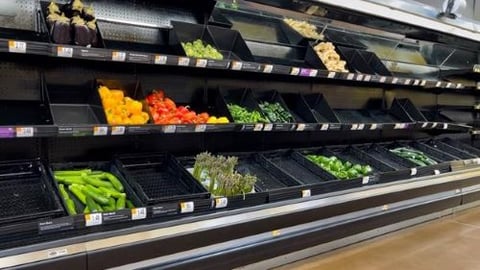Weather Events Taking a Toll on Crops, Price Points
The ripple effect of recent weather events is being felt throughout the supply chain, ultimately leading to higher prices for some grocery items. In addition to the devastating Hurricane Ian that heavily damaged Florida's orange groves and vegetable crops, longer drought conditions in parts of the United States are having an impact at the point of sale.
California has been particularly hard hit by a drought that started in 2020 and continued through this year with low amounts of snowpack and rainfall. According to the State of California – which just began its new water year on Oct. 1 – the first three years of this decade are now the driest on record, dating back to 1896.
“As we enter the 2023 water year, we remain hopeful for a drought-ending season but understand that business as usual is a not a path forward,” declared Don Cameron, president of the California State Board of Food and Agriculture and a local grower of almonds and other crops. “California agriculture must do its part to reduce overall demand while maintaining family farms, markets, communities and our overall food security.”
California's Central Valley, which spans about 20,000 square miles and is planted with more than 250 different crops, traditionally produces more than a quarter of the agricultural food products in the United States. The drought there has taken a significant toll on harvests as of late, particularly tomatoes and onions. This month, the Reuters news service reported that the U.S. Department of Agriculture (USDA) reduced its forecast for processing tomatoes grown in California by 10% for 2022. Meanwhile, the California Rice Commission has downgraded its projection for the year's rice production from 500,000 to 250,000 acres.
Water levels aren’t just low in California. The lingering Western drought has impacted water reservoirs – and, in turn, farmers – in other states that grow a variety of crops and also rely on water for the raising of cattle and other livestock. The USDA’s Economic Research Service (ERS) confirmed the scope of the crisis, noting that as of July 11, drought conditions were most severe in California, Texas, Oregon, Nevada, Utah and New Mexico; the ERS reported that more than 32% of land in the western United States was classified as experiencing extreme or exceptional drought.
More recent data is also worrisome. The National Integrated Drought Information System (NIDIS) shared on its drought.gov website that 44.04% of the country and 52.55% of the lower 48 states were in drought during the week of Sept. 28 through Oct. 4, up 19% from the previous month and 3.3% from the previous week.
Fresh supply chain problems have resulted from the situation over the past weeks. “Low water levels are impacting barge traffic on the Mississippi River during the harvest, a crucial time,” NIDIS pointed out, citing a lack of rainfall since late August in the region. Barge traffic was halted for a time last week, as some got stuck in muck.
The impact of drought conditions, along with the expected fallout from Hurricane Ian in the Southeast, is compounded by other market factors. As crops have dwindled, farmers across the country are still contending with high fuels costs for their tractors, more expensive fertilizer and feed and ongoing labor shortages.
Retailers and consumers are accordingly feeling the pinch. The ERS will release new Consumer Price Index (CPI) and Producer Price Index (PPI) data on Oct. 25 but as of late September, the agency shared that the CPI for food rose 0.8% from July to August and was up 11.4% compared to August 2021, attributable in at least in some part to volatile agricultural circumstances.
Meanwhile, the PPI for unprocessed foodstuffs and feedstuffs climbed 23.1% from August 2021 to August 2022, while processed foods and feeds rose 13.1% and finished consumer foods increased 13.9% during the same time period. The PPI for farm-level fruits jumped 21.8% on year-over-year basis and rocketed 45.2% higher for farm-level vegetables. The PPI rate was slightly lower for wheat, up 4% over August 2021 and for soybeans, up 9%.






